It’s a new year, and I know, we’ve all been there: setting and trying to keep goals for ourselves involving more exercise and healthy eating. There are actually small ways to stay healthy in ways that are barely noticeable. By adding seeds to the healthy things you already eat, you’re also adding a bunch of awesome nutrients like fiber, iron and protein. Without a doubt, these tiny supplements can quickly add a big boost your nutrition.
We’re not talkin’ almonds, peanuts, or walnuts—those guys are too basic. Here are four staple seeds that you’ve probably heard about, and can get your New Year’s diet into full swing:
1. Chia Seeds

Photo courtesy of shredfat.com
Ch-ch-ch-chia. Yes, I know exactly what you’re thinking: these ARE the same chia seeds as your Chia Pet from way back when. What you probably didn’t know is that these small black (or white) seeds are edible and chock-full of omega-3 fatty acids, carbs, proteins, fiber, antioxidants and calcium. Who knew.
Popping one in your mouth by itself, you might notice a mild and nutty taste. When combined with other foods, this flavor basically disappears, so feel free to sprinkle away. Not only are they a pretty invisible superfood, but they also help keep the pounds off and keep a healthy heart pumping. Low in calories but full of nutrients, these small seeds make you feel full for longer and feeling pretty energized. Heaven knows we need all the energy we can get.
Try with: Oatmeal, yogurt, mixed into baked goods (i.e. muffins, pancakes, waffles, smoothies and açaí bowls). If you really become a fan, try chia seed pudding. It’s a super healthy and easy breakfast, snack and dessert food. Easy.
Recommended dose is just under two tablespoons (20 grams/70 calories) a day. Sounds like a lot, but it goes quickly I promise.
2. Flaxseeds

Photo courtesy of gourmetstore.com
Flaxseeds have been around for quite some time—try as far back as 3000 B.C. Even Charlemagne knew about their health benefits back in the 8th century. I guess you could say he was a trendsetter?
Flax has long-lasting health benefits, and like chia, the seeds are rich in fiber, healthy omega-3 fats and lignans. They’re kinda crunchy, but again, barely noticeable. The ground flax variety pretty much dissolves right into any liquid mixture.
There are even more benefits; these yellow to golden brown seeds produce healthy oils and protect against heart disease, high cholesterol, diabetes and some cancers. Listen to this one: ground flaxseed is actually better for you than eating the entire raw seed. Lucky for you (and me), 16-oz. bags are in almost any grocery store.
Try with: Oatmeal, soup, or ground flax in boiled and salted rice.
Recommended dose is just under two tablespoons (35-75 calories) a day. This is not too hard of a goal at all.
3. Pumpkin Seeds

Photo by Tochi Mgbenwelu
Next fall when you’re carving a pumpkin for Halloween, remember this: you can wash the slime off the seeds after scraping them out and keep ’em for later. Now that’s how you maximize the pumpkin. What is pretty cool is that pumpkin seeds have a traditional medicinal history in countries like India and Mexico. While they taste the best roasted, they also can be eaten raw and used in baking or cooking. Score.
These flat, light green and chewy treats are a natural source of iron, protein, and potassium. Don’t forget all the vitamins like B, C, and D—sounds like a fruit with all those vitamins, but nope. With all we have to deal with as college students, we are not strangers to anxiety or depression, and these seeds can actually help with these conditions.
Try with: Salad, trail mix, and baked in muffins or pancakes.
4. Quinoa

Photo by Tochi Mgbenwelu
Named one of the world’s healthiest foods, but definitely difficult to pronounce (Kwee-no-ah? Keen-wa?), this crop is also a “superfood,” with origins in the Incan Empire of Colombia. Hear me out, the part of quinoa that we eat is actually a seed NOT a whole grain. Even though we prepare it just like rice and barley, the next time someone says it’s a grain you can chuckle and correct them.
Eat quinoa and know that your diet will have fiber, calcium, protein (a “complete protein” for that matter) and all nine essential amino acids. The taste and texture is fluffy and a delicious cross between “brown rice and oatmeal.” I’m not that good at math, but with over 100 varieties, there are literally enough to create THOUSANDS of concoctions in the kitchen to last many New Year’s diets in the future.
Look out, because for those of you with diet restrictions, you may now rejoice because quinoa is naturally kosher, cholesterol and gluten free.
Try with: Salads, stir-fry, or in place of rice. Just add some salt, olive oil or lemon juice to eat alone, too.
The list of seeds and diet supplements doesn’t stop here, what are you waiting for? learn more here.
Still looking for your information to grow? Check out these articles:

